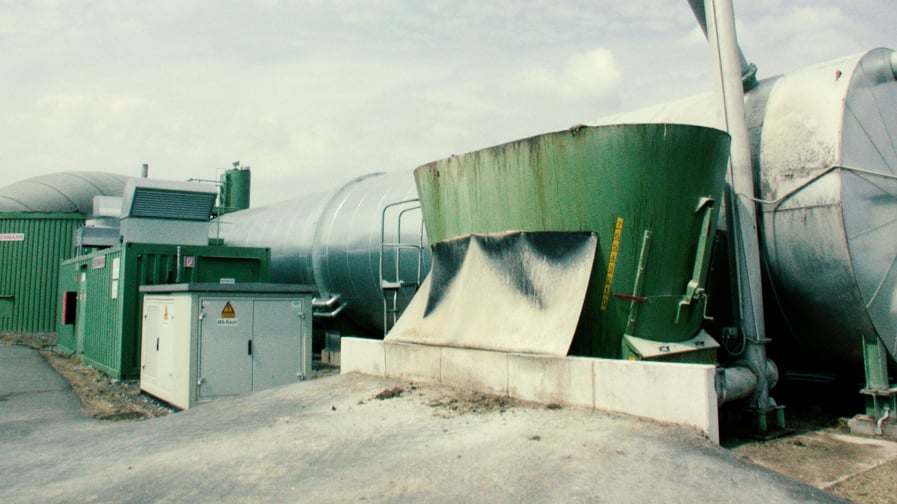What You’ll Learn From This Report
Introduction
A new, dangerous form of corporate consolidation is sweeping the nation: the marriage of Big Oil & Gas with Big Agribusiness. Decades of organizing has exposed oil and gas companies for their roles in perpetuating and covering up the climate crisis.1Waldman, Scott. “Shell grappled with climate change 20 years ago, documents show.” E&E News. April 5, 2018; Banerjee, Neela. “Exxon’s oil industry peers knew about climate dangers in the 1970s, too.” Inside Climate News. December 22, 2015. Similarly, industrial agriculture companies are under scrutiny for their role in creating the polluting and unjust factory farm system.2McGreal, Chris. “How America’s food giants swallowed the family farms.” Guardian. March 9, 2019.
Faced with this, Big Oil and Big Ag are desperately trying to rehabilitate and greenwash their public images. Their new favorite “green” buzzword — biogas — and its false promises of “renewable natural gas” is one way in which these two polluters are teaming up in attempts to do just that.
Bearing President Biden’s stamp of approval, and picking up millions in federal funding, Big Ag and Big Oil are throwing big money behind this myth of “green gas.” This myth is a smokescreen to distract from these industries’ bread and butter — climate, water, and air pollution.
In this report, Food & Water Watch maps extensive industry investments in factory farm gas, detailing how the biggest fossil fuel and agriculture polluters are teaming up to profit on the myth of green gas. The report outlines how massive public investments have driven this latest feeding frenzy for corporate polluters. Ultimately, this investment has turned our agricultural system on its head, making producing food a byproduct of a profitable manure industry. The implications for the climate crisis are severe.
Betting Big on Factory Farm Gas
Big Oil and Big Ag are funneling money into factory farm gas. Private investment in factory farm gas has tripled since 2017, rising to over $1.6 billion.3Douglas, Leah and Nichola Groom. “Biden spending bill ignites debate over dairy methane pollution.” Reuters. January 11, 2022. Three of the biggest United States oil companies and the nation’s largest pork producer are betting big on factory farm gas, spending billions across the industry.4Shell. [Press release]. “Shell to acquire renewable natural gas producer Nature Energy.” November 28, 2022; Bousso, Ron and Ruhi Soni. “BP to buy U.S. biogas producer Archaea for $4.1 bln.” Reuters. October 17, 2022; Chevron. [Press release]. “Chevron, Clean Energy Fuels extend Adopt-A-Port initiative to reduce emissions.” May 11, 2021; Barnes, Greg. “Smithfield’s plans to cover hog lagoons could spur N.C. biogas industry.” NC Health News. January 4, 2019. Thanks to this investment, across the U.S., the number of planned and operational factory farm gas facilities jumped by over a third in 2021 compared to 2020.5Fu, Jessica. “Brown gold: The great American manure rush begins.” Guardian. February 2, 2023.
An industry around designing and building digester projects has sprung up alongside this money, with the top independent firms growing 300 percent from 2019 to 2020.6American Biogas Council. “ABC announces the 8 fastest growing biogas businesses.” Biogas Magazine. March 17, 2021. Between three of the largest oil companies in the U.S., there are five joint ventures with these types of factory farm gas companies,7Singh, Shradha. “Chevron, Brightmark form JV for dairy biomethane fuel project.” Reuters. October 7, 2020; Clean Energy Fuels Corp. [Press release]. “Clean Energy and BP create JV to invest in RNG fuel production.” March 10, 2021; Voegele, Erin. “Gevo begins startup of Iowa RNG project.” Biomass Magazine. February 1, 2022; BP. [Press release]. “CleanBay Renewables to sell BP RNG derived from poultry litter.” August 24, 2021. and they own or finance up to 143 digesters or upgrading facilities.8Chevron. “Chevron and CalBio biogas partnership.” July 1, 2020. Available at https://www.chevron.com/stories/chevron-calbio-biogas-partnership.; Chevron. [Press release]. “Chevron, CalBio expand partnership on dairy biomethane fuel projects.” October 6, 2022; Brightmark. “Renewable Natural Gas Projects.” Available at https://www.brightmark.com/renewable-natural-gas/projects. Accessed December 2022; Bousso and Soni (2022); BP (August 2021); Shell (2022). Shell and BP each purchased one of these companies in 2022, spending over $6 billion combined.9Shell (2022); Bousso and Soni (2022). Before 2017, not a single one of these companies used the terms “biogas” or “renewable natural gas” in any of their corporate sustainability reports.10FWW analysis of Chevron. Annual Reports and Sustainability Reports from 2018 to 2020. Available at https://www.chevron.com/newsroom/media/publications. Accessed March 2023; BP. Sustainability Reports from 2016 to 2020. Available at https://www.bp.com/en/global/corporate/sustainability/reporting-centre-and-archive.html. Accessed March 2023; Shell. Annual Reports and Sustainability Reports from 2017 to 2018. Available at https://www.shell.com/about-us/annual-publications/annual-reports-download-centre.html. Accessed March 2023.
On the Big Ag side, Smithfield is a leading biogas proponent. Smithfield alone has three joint ventures, two of which are with Dominion and Duke Energies respectively. They operate on at least 115 factory farms across the country.11Align RNG. “Projects.” Available at https://alignrng.com/projects.aspx. Accessed March 2023; Barnes (2019); Freese, Betsy. “83 Smithfield lagoons in Missouri now producing renewable natural gas.” Successful Farming. May 4, 2021. Other Big Ag names, like Perdue and Tyson, are just beginning to enter the factory farm gas bonanza.
Oil and Gas
Chevron considers itself “well positioned” to be a “U.S. market leader in RNG,” committing over half a billion dollars to factory farm gas as of September 2021.12Chevron. [Presentation]. “Energy Transition Spotlight.” September 14, 2021 at 18. Chevron’s most notable partnership is with California Bioenergy, or CalBio. Their current collaborations include more than 80,000 cows, and they view the other 1.8 million cows in California as opportunities to grow13Chevron (July 2020). — rather than scale back — factory farms. Chevron initially helps fund the digesters and then sells all the gas in California markets,14Ibid.; Chevron. [Press release]. “CalBio, dairy farmers and Chevron announce first RNG.” September 24, 2020. where financial incentives are higher for biogas than for any other fuel source.15California Air Resources Board (CAARB). “LCFS Pathway Certified Carbon Intensities.” Available at https://ww2.arb.ca.gov/resources/documents/lcfs-pathway-certified-carbon-intensities. Updated February 28, 2023; Legislative Analyst’s Office. Presented to Assembly Select Committee on California’s Energy Future. “Overview of the Low Carbon Fuel Standard.” June 19, 2018 at 2.
Although this is its most well-known joint venture, Chevron does not stop there — it is also partnered with the digester company Brightmark. The partnership began in 202016Singh (2020). and expanded again in 2021,17Chevron. [Press release]. “Chevron, Brightmark expand partnership of dairy biomethane fuel projects.” August 24, 2021. with at least 18 digester projects spread across 8 states.18FWW analysis of Brightmark. Chevron also purchased biodiesel maker Renewable Energy Group for $3.15 billion in February 2022 — its largest alternative fuel purchase to date.19Krishna, Rithika and Laura Sanicola. “Chevron raises clean energy bet with $3 billion Renewable Energy Group deal.” Reuters. February 28, 2022.
BP is similarly embedded in the factory farm gas market, saying to investors that part of its strategy to drive higher returns is to “grow biogas production and marketing.20BP. [Presentation]. “BP Full Year & Fourth Quarter 2021 Financial Results & Update on Strategic Progress.” February 8, 2022 at 24. One of BP’s most prominent joint ventures was with Archaea Energy and Aligned Digesters, which formed in June 2020 to develop four new dairy projects in the California Central Valley. The gas would then be injected into the Pacific Gas & Electric gas pipeline to be sold into fuel markets, with an anticipated cost of $29.5 million.21Carruth, Stefani. Prepared for CA Alternative Energy and Advanced Transportation Financing Authority. Application No. 21-SM030. May 18, 2021; BP. [Press release]. “BP and Aria Energy to capture methane at California dairy farms as part of renewable natural gas project.” March 18, 2021. The joint venture did not last long, however, as BP moved to buy Archaea Energy and absorb its projects in October 2022 in the largest-yet factory farm gas acquisition at $4.1 billion.22Bousso and Soni (2022).
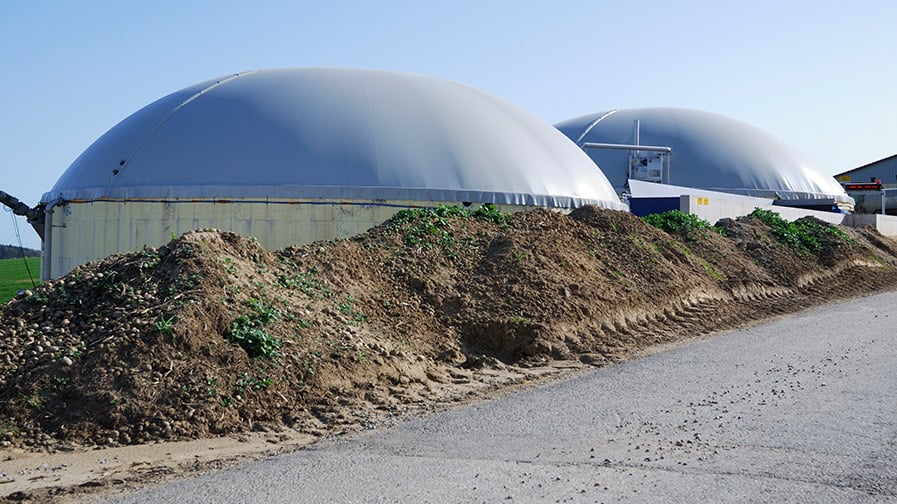
BP also invested more than $50 million into its venture with Clean Energy Fuels, in which the pair develops, owns, and operates projects at dairies.23Clean Energy Fuels Corp. (2021). This works in tandem with BP’s agreement with Gevo NW Iowa RNG, from which BP buys factory farm gas produced from more than 20,000 cows in Iowa.24Voegele (2022); “Iowa plant turns cow manure into RNG.” Gas Compression Magazine. February 6, 2022. The real money for projects like this can come from pollution trading programs like California’s,25Lee, Hyunok and Daniel A. Sumner. “Dependence on policy revenue poses risks for investments in dairy digesters.” California Agriculture. Vol. 72, No. 4. December 17, 2018 at 9 to 10. and, in this case, factory farm gas is monetized by BP through agreements with Clean Energy Fuels Corp.26Voegele (2022). BP also has a 15-year agreement with CleanBayRenewables to buy gas made from poultry litter, to then sell in California.27BP (August 2021).
Not to be left behind, Shell is sponsoring projects in Idaho, Oregon, and Kansas, plus a fueling distribution site in California.28Jones, Emily. “Shell Oil constructing manure-to-gas conversion facility in Gooding County.” Idaho Mountain Express. November 4, 2021; Shell. “Shell New Energies Junction City, Biomethane Facility.” Available at https://www.shell.us/about-us/projects-and-locations/shell-new-energies-junction-city–biomethane-facility.html.; Shell. “Shell Downstream Galloway, Biomethane Facility.” Available at https://www.shell.us/about-us/projects-and-locations/shell-downstream-galloway–biomethane-facility–plains–kansas–.html.; Shell. “Carson Renewable Compressed Natural Gas Fueling Site.” Available at https://www.shell.us/about-us/projects-and-locations/carson-renewable-compressed-natural-gas-fueling-site–carson–ca.html. Accessed March 2023. As of November 2022, the company has one operational site and four under construction.29Shell (2022). Shell also purchased the largest factory farm gas producer in Europe, Nature Energy, for $2 billion that November.30Ibid. The company is looking to set up in Minnesota and Wisconsin, using dairies and local pipeline infrastructure to do so.31Beach, Jeff. “Nature Energy brings large-scale manure-to-energy projects from Denmark to Minnesota.” AgWeek. November 15, 2022.
Agriculture
Smithfield has centered its greenwashing efforts on factory farm gas, proclaiming that it will use up to 100 percent of its hogs on company-owned factory farms in four states to generate this gas.32Dietrich, Tamara. “Dominion, Smithfield Foods double their investment to turn pig manure into energy.” Daily Press. November 4, 2019. The company has partnered with several utilities, namely Dominion Energy and Duke Energy, to work toward this. Smithfield’s joint venture with Dominion, Align RNG, already spans Arizona, North Carolina, Utah, and Virginia,33Align RNG (2023); Barnes (2019). with California, Colorado, Iowa, and Missouri flagged for expansion.34Dietrich (2019).
These projects, and the most viable factory farm gas projects, entail covered manure “lagoons,” or massive cesspools filled with liquid effluent.35Lazenby (2022) at 18. Smithfield uses these cesspools to produce the gas, which is then upgraded to be shipped through underground pipelines.36Dietrich (2019). These “lagoon” systems are also responsible for a host of other environmental and public health issues like contamination of drinking water and harmful algal blooms in rivers and lakes — pollution problems that the gas production process can make worse.37Gilbert, Patricia M. “From hogs to HABs: Impacts of industrial farming in the US on nitrogen and phosphorus and greenhouse gas pollution.” Biogeochemistry. Vol. 150. July 22, 2020 at abstract and 143; U.S. Department of Agriculture (USDA). Natural Resource Conservation Service. “Conservation Practice Standard: Anaerobic Digester.” Code 366. October 2017 at 6.
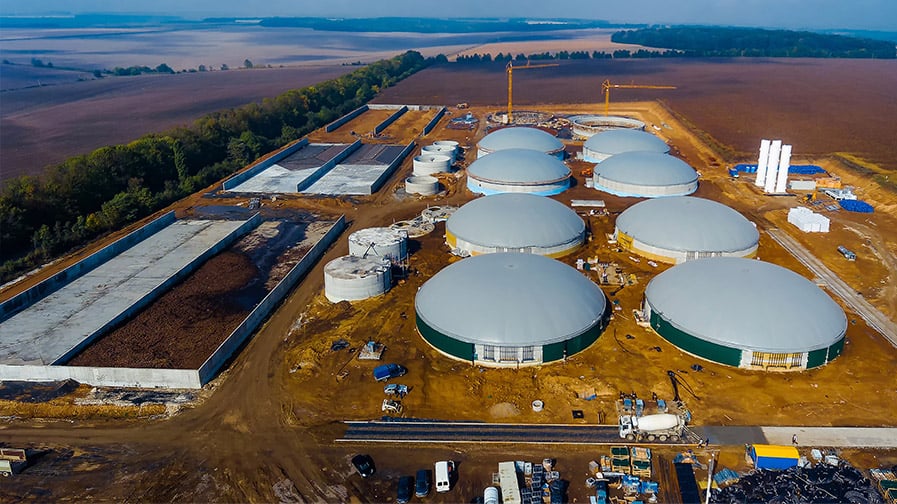
Smithfield and Dominion Energy will pay for the dangerous infrastructure to inject gases into pipelines, but farmers are on the hook for digesters and lagoon covers, extremely expensive technologies.38Barnes (2019). Similarly, Smithfield and Duke Energy’s Optima KV project uses five farms with digesters, injects the gas into pipelines owned by Piedmont Natural Gas, and sells to Duke Energy.39Ibid. Smithfield has an additional joint venture with Roeslein Alternative Energy, called Monarch Bioenergy, which installs digesters on Smithfield’s Missouri farms.40Smithfield. “2021: Our 20th Annual Sustainability Impact Report.” 2022 at 29. Its eight digester projects in Missouri are valued at $150 million.41Ibid. at 31.
Not to be outdone, other Big Ag giants are also getting in on the profits and greenwashing. Perdue, for instance, entered into an agreement with Bioenergy Devco to sell a 20-year supply of Perdue poultry and hatchery byproducts to Bioenergy Devco’s factory farm gas facility.42Bioenergy Devco. [Press release]. “Bioenergy DevCo to purchase Perdue AgriRecycle organic soil composting facility in Delaware.” November 21, 2019. Bioenergy Devco has applied for permits for the first proposed industrial poultry waste digester in the area.43First-Arai, Leanna. “Biogas from America’s favorite meat: Pollution solution or a prop for poultry?” Food & Environment Reporting Network. December 13, 2021. Tyson, meanwhile, partnered with NW Natural to generate gas from beef packaging plants, beginning in Nebraska in 2021.44Adair, Rick. “NW Natural proposes RNG project in Nebraska for Tyson Foods.” Clearing Up. January 8, 2021. The project cost was an estimated $8 million, although the company was looking to defer costs.45Ibid. This is only a taste of how these companies are getting into the industry, and there is good reason to believe they all have their eyes on expanding factory farm gas.
Public Incentives and Pollution Trading Fuel the Schemes
Public money funds these private profits. In a study of a California digester, more than 90 percent of the digester’s revenue came from selling government-endorsed environmental credits. Selling fuel on the market brought in only $149,000, while federal and state programs generated a staggering $1.9 million.46Lee and Sumner (2018) at 9 to 10. At least 71 programs across 31 states are offering financial incentives for anaerobic digesters, including corporate tax credits and grant programs.47North Carolina Clean Energy Technology Center. Database of State Incentives for Renewables & Efficiency (DSIRE).“Programs.” Available at https://programs.dsireusa.org/system/program and on file with FWW. Accessed February 2023. These programs have varying levels of success, with some funding digesters that fail repeatedly and destroy the local environment.48McKenzie, Jessica. “The misbegotten promise of anaerobic digesters.” Counter. December 3, 2019.
However, the most developed state program for digesters to turn a profit off is undoubtedly California’s Low Carbon Fuel Standard (LCFS) program.49Lazenby (2022) at 14. The LCFS is a pollution trading program, designed to help decarbonize the transportation sector by offering credits for fuels with lower carbon intensity. The state considers factory farm gas to have the lowest transportation carbon intensity.50CAARB. “Low Carbon Fuel Standard: About.” Available at https://ww2.arb.ca.gov/our-work/programs/low-carbon-fuel-standard/about. Accessed February 2023 and on file with FWW; Whitfield, Derrick et al. Stifel Equity Research. “Energy & Power — Biofuels: Renewable Natural Gas.” March 8, 2021 at 11. For all its buzzwords, this policy incentivizes continued emissions and expanded production. California’s LCFS and Cap-and-Trade programs are the main source of revenue for factory farm gas projects,51AcMoody, Annie and Paul Sousa. Western United Dairies. “Interest in California Dairy Manure Methane Digesters Follows the Money.” CoBANK. August 2020 at 1. and companies are centering their factory farm gas business models around this funding.52Lazenby (2022) at 12.
Federal funding is another gold mine. The U.S. Department of Agriculture (USDA) is eager to fund anaerobic digesters, offering loan and grant programs to finance the schemes. Tom Vilsack, the Secretary of Agriculture, has voiced his adamant support for digesters since 2013.53Whitfield et al. (2021) at 11. Even during some of the earliest iterations of federal endorsements, funding for digesters was only made available for massive factory farms, requiring at least 1,000 animal units to qualify.54McKenzie (2019).
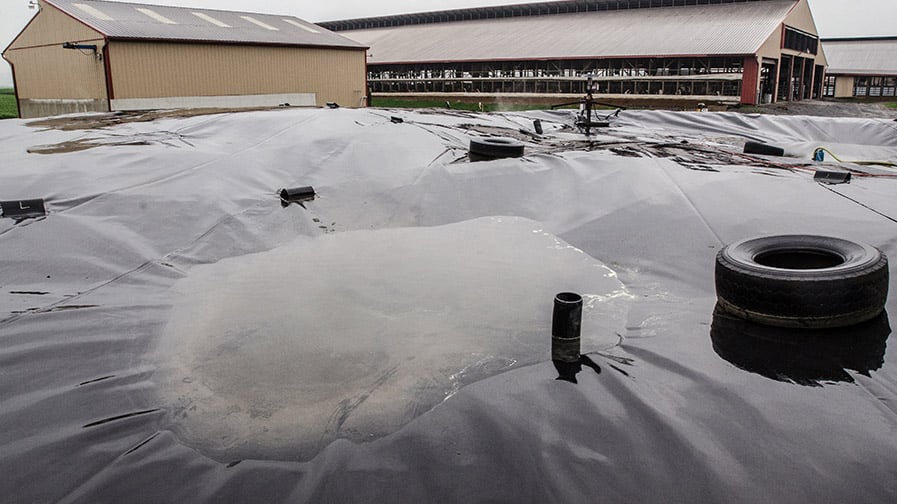
President Biden also endorsed digesters in his 2021 Methane Emissions Reduction Plan, which calls for expanding on “incentive-based and voluntary partnership efforts” to reduce the agricultural sector’s methane emissions. Biden has advocated for increased biogas funding, programs, and research to scale-up this so-called renewable energy.55White House Office of Domestic Climate Policy. “U.S. Methane Emissions Reduction Action Plan.” November 2021 at 11 to 12.
The federal Renewable Fuel Standard is similar to the LCFS. Petroleum refiners or importers must obtain credits, known as renewable identification numbers, or RINs, to meet renewable fuel targets set by the U.S. Environmental Protection Agency (EPA).56Rosengren, Cole. “How the EPA’s Renewable Fuel Standard program changes could be a boon for landfill and AD operators.” WasteDive. February 16, 2023. RINs can then be sold to or used by conventional fuel producers to meet EPA quotas.57Lazenby (2022) at 12. A variety of biogas feedstocks qualify under this program, including manure-based factory farm gas. Biogas is once again considered the most valuable of renewable fuels. Problematically, these credits can be layered onto other programs like the LCFS.58Whitfield et al. (2021) at 11. New proposals in the works would allow for even more expansion in the biogas industry, by allowing new credits to be generated from burning factory farm gas in inefficient generators to produce electricity.59“Unpacking EPA’s e-RIN proposal.” Biocycle. December 20, 2022.
The 2022 Inflation Reduction Act (IRA) further expanded financial incentives for biogas, signaling steady federal support. The IRA extended the Section 48 Energy Investment Tax Credit to include a 30 percent credit for “qualified biogas properties” — the same amount given to wind and solar. This could be hiked up to 50 percent if projects are sited in “high energy areas” or brownfields, which are already unduly burdened by environmental injustices. These credits include factory farms, which will benefit immensely. The legislation also invested $2 billion into the USDA’s Rural Energy for America Program (REAP), providing loans and grants to biogas facilities and farmers.60350Brooklyn et al. Letter to Secretary Tom Vilsack. USDA. December 7, 2022. Available at https://aldf.org/wp-content/uploads/2022/12/USDA-letter-biogas-funding-IRA-filed-12.7.22.pdf; McCracken, John. “A new tax credit for biogas could be a boon to factory farms.” Grist. November 1, 2022; Levin, Michael H. “The IRA revolutionizes AD tax credits.” BioCycle. August 23, 2022.
Industry groups are aware of these changes and expect massive expansions to go along with them. With the implementation of the IRA, the American Biogas Council envisions 8,600 new digesters on factory farms with dairy cows, hogs, and poultry.61Schneider, Keith. “A push to turn farm waste into fuel.” New York Times. April 4, 2023. It is well known that, without this level of public funding, the projects would fail. Digesters are too dependent on government subsidies to be viable on their own, meaning that if policy were to ever change surrounding digesters, they would become too risky for private investment.62Lee and Sumner (2018) at 13. Companies openly admit that incentives are the reason for digester profitability,63Lydersen, Kari. “Biogas expansion may compound worker risks.” Energy News Network. November 16, 2022. and as of 2023, Big Oil is already rolling in record profits64Leber, Rebecca. “Oil company profits are at a record high. It won’t last.” Vox. February 8, 2023. as this government money continues to pour in.
Investment Drives More Climate Emissions
As manure goes from a waste stream to a revenue stream, corporations are eager to cash in. Public investment pouring into factory farm gas is creating perverse incentives, where animal agriculture could become more about maximizing manure production over animal products.65Smith, Aaron. “What’s worth more: A cow’s milk or its poop?” UC Davis. February 3, 2021; Kelloway, Claire. “Big Ag and Big Oil eye biogas profits, Shell buys Nature Energy.” Food & Power Net. December 7, 2022. The system itself depends on generation of emissions to remain financially viable, doing nothing to reduce emissions from the source.66Lazenby (2022) at 24. By locking in existing herd sizes and even incentivizing expansion, increasing biogas investment risks parallel increases in greenhouse gas emissions.67Ibid.; Kelloway (2022).
Livestock production accounts for 36 percent of all methane emissions in the U.S.68U.S. EPA. “Methane Emissions in the United States: Sources, Solutions & Opportunities for Reductions.” May 23, 2019 at 4. Big Oil and Big Ag call their factory farm-derived biogas a “transformational opportunity” and “carbon negative” fuel,69Chevron (October 2022); Johnson, Kristen. “Smithfield project that converts hog waste to energy angers, worries rural NC residents.” Fayetteville Observer. January 21, 2021. and many top public officials are buying into it.70Office of Governor Gavin Newsom. [Press release]. “Governor Newsom announces climate pollution continues to drop below 2020 target while state’s economy grows.” August 12, 2019; White House Office of Domestic Climate Policy (2021) at 11 to 12. The reality, however, is much harsher — in fact, if digesters were installed at every dairy farm in the nation, they would not reduce the agricultural sector’s greenhouse gas emissions by even 25 percent.71Gittelson (2022) at 355.
This is partly because factory farm gas fails to address enteric fermentation, which contributes more to overall emissions than manure.72Lazenby (2022) at 25; U.S. EPA (2019) at 4. Enteric fermentation occurs in the digestive systems of ruminants like cattle and produces methane as a by-product. This alone accounts for 27 percent of U.S. methane emissions, while manure management contributes livestock’s remaining 9 percent (see Fig. 1).73U.S. EPA (2019) at 17 to 18; Food and Agriculture Organization of the United Nations. “Livestock and enteric methane.” Available at https://www.fao.org/in-action/enteric-methane/background/en. Accessed February 2023; Lazenby (2022) at 25. Factory farm gas does nothing to address these emissions.
Digester systems are also riddled with leaks. Research shows that methane emissions along the supply chain are significantly underestimated — as much as double previous estimates.74Bakkaloglu, Semra et al. “Methane emissions along biomethane and biogas supply chains are underestimated.” One Earth. Vol. 5. June 17, 2022 at abstract. Just like in traditional oil and gas supply chains, super-emitters are a major, persistent problem, with the highest 5 percent of emitters contributing over 60 percent of cumulative emissions.75Ibid. at abstract and 727. But unlike traditional systems, factory farm gas has much higher loss rates.76Ibid. at 727 and 731. Methane leaks could be as high as a 15 percent loss rate, with the potential to release significant amounts of methane annually. Due to this, factory farm gas cannot be a zero-greenhouse gas emission fuel, let alone a negative emission fuel, at scale.77Grubert, Emily. “At scale, renewable natural gas systems could be climate intensive: The influence of methane feedstock and leakage rates.” Environmental Research Letters. Vol. 15. August 11, 2020 at abstract and 7.
Some projects also require the use of propane to function. In one poultry litter study, because the digester was so ineffective at creating electricity, the system required over 4,300 gallons of propane annually to heat it. This obliterated any claims of climate benefits, instead generating over 1,100 percent of the climate change impacts that simply transporting unprocessed litter would have created.78Lansing, Stephanie and Amro Hassanein. “Poultry litter anaerobic digestion.” University of Maryland Extension. ND at 3.
As an end-use, burning factory farm gas produces the same pollutants as any fossil fuel source of energy.79Gittelson (2022) at 355. On top of this, the transport of gas and materials to and from digesters still requires massive amounts of toxic diesel fuel.80CalEPA (2010) at 6. Additionally, if the gas is not sent for upgrading to turn a profit off of, it may simply be flared off, releasing the gas back into the atmosphere.81“Three CA LCFS pathway applications for swine manure to Bio-CNG, Bio-LNG, and Bio-L-CNG; Negative triple-digit Cis.” Green Car Congress. December 29, 2019. When factory farm gas substitutes real renewable sources, like wind and solar, emissions will increase,82Esteves, Elisa Maria Mano et al. “Life cycle assessment of manure biogas production: A review.” Journal of Cleaner Production. Vol. 219. 2019 at 412. preventing a necessary transition away from fuel emissions and dooming us to climate chaos.
For poultry digester systems, the emissions are even worse. Methane from poultry manure is less than 6.1 percent of that generated from cow and hog manure (see Fig. 2). Broilers, pullets, and turkeys, which represent over three-fourths of poultry, are commonly raised on bedding materials, also called poultry litter, which consist of wood shavings, straw, or rice hulls. This litter produces minimal methane emissions to begin with, making it unsuited for digestion.83U.S. EPA. “Anaerobic digestion on poultry farms.” EPA 430 F 22 004. So for most poultry digesters, when the system leaks or the gas is burned in cars, it generates new methane emissions that would not have existed without digesters.
Behind all of this, U.S. methane emissions are worsening, not improving. Since the Obama administration’s endorsement of dairy digesters in 2009, the industry’s methane emissions have risen by over 15 percent. This is partly the result of growing herd sizes,84Douglas and Groom (2022). a trend that will only worsen with continued biogas subsidies incentivizing growth.85Kelloway (2022). Factory farms are developing new projects or expanding existing herd sizes alongside the development of digesters, creating new sources of methane that did not exist before.86Held, Lisa. “Are biogas subsidies benefiting the largest industrial animal farms?” Civil Eats. September 20, 2021.
And since there are limited amounts of feedstocks, factory farm gas will never scale up enough to replace fossil or fracked gas,87French, David. “CERAWEEK-Renewable natural gas land grab ends as suppliers turn to sales.” Reuters. March 9, 2023. enabling such a friendly relationship between Big Ag and Big Oil. When looking at all potential feedstocks, national assessments find that the available waste streams could only account for around 7 percent of U.S. natural gas consumption.88Cyrs, Tom et al. World Resources Institute. “Renewable Natural Gas as a Climate Strategy: Guidance for State Policymakers.”. Working Paper. December 2020 at 2. One state assessment found that gas from animal waste makes up less than 5 percent of this in all scenarios studied.89ICF Resources LLC. Prepared for Michigan Public Service Commission. “Michigan Renewable Natural Gas Study.” September 23, 2022 at 4 to 5.
All told, this is an extremely dangerous trend for our climate, and it is being enabled by federal funding. Biden’s USDA continues to push full force for digesters despite these realities and pushback. Several U.S. senators raised concerns to the agency around the programs, writing that USDA has not produced evidence that subsidizing digesters will reduce absolute emissions.90Office of U.S. Senator Cory Booker. [Press release]. “Booker, Gillibrand, Sanders, Warren, Markey Urge EPA and USDA to Limit New Incentives for Factory Farm Biodigesters.” August 24, 2022. If cows were raised sustainably on pasture, and there were fewer of them, the debate over manure methane emissions would not be a debate. Pasture-based systems do not produce significant emissions from manure, as pasture-raised cattle’s manure dries on pasture and produces negligible methane.91Lee and Sumner (2018). Instead, in efforts to maintain the status quo factory farm system, biogas systems are generating methane from leaky systems and, in some cases, worsening existing emissions.
All Talk, No Change
Big Oil is using “biogas” and similar industry-backed initiatives as smoke screens for the reality that they have no plans to turn away from oil and gas production and are instead planning increased exploration and production. Big Ag is doing the same, as they have no intention of turning away from the industrial factory farm system that fuels the climate crisis.
Chevron, BP, and Shell echo these sentiments in their strategic plans, with each planning to scale up their factory farm gas production over the next decade.92Chevron. “Climate Change Resilience: Advancing a Lower Carbon Future.” Updated October 21, 2021 at 49; BP (February 2022) at 30 to 31; Shell. [Report]. “Shell Energy Transition Strategy.” 2021 at 5. But their real goals, it is clear, remain in oil and gas — overall oil production was 9,299 thousand barrels per day in January 2023, up from 8,436 thousand barrels per day in January 2022 (see Fig. 3).93U.S. Energy Information Administration (EIA). “Drilling Productivity Report.” January 18, 2022; EIA. “Drilling Productivity Report.” January 17, 2023.
Amid huge profits, Big Oil has become emboldened enough to back away from its promises of a renewable future. BP reduced its emission pledges, dropping from 35 to 40 percent lower emissions by 2030 to just 20 to 30 percent.94Leber (2023). Shell spends a mere 1 percent of its capital expenditures on wind and solar, the only truly renewable energy sources in its portfolio. Even when Shell invests in greenwashed schemes, like factory farm gas or so-called carbon capture, its investment amounts to less than half of its oil exploration and production investments.95Ibid.
Smithfield is no better. Manure makes up the largest portion of the company’s emissions, but it does not use the factory farm gas to power its own operations. Rather than using it on-site, the gas is largely sent outside of the company. Natural gas is still the dominant source of energy at Smithfield’s U.S. facilities and farms, with even less factory farm gas used in 2021 than in prior years.96Smithfield (2022) at 27 and 85. The company can instead cash in on the LCFS by piping or trucking gas from Missouri all the way to California.97Green Car Congress (2019). Meanwhile, it has joined the USDA and EPA’s list of “U.S. Food Loss and Waste 2030 Champions” as well as several other organizations with gaudy, greenwashed titles.98Smithfield. [Press release]. “Smithfield Foods commits to reduce food loss and waste 50% by 2030.” January 5, 2022. Since 2013, it appears that the key indicator of success in Smithfield’s alternative energy campaigns is not reduced emissions — it is cost avoidance and better publicity.99Rodgers (2013).
Why Is It Greenwashing?
With these industries unleashing public relations campaigns and ads to convince the world of their new strategies,100Chevron. “Fuels of the Future.” Available at https://www.youtube.com/watch?v=cepfPg-QgiA. Accessed February 2023. it can be difficult to unravel the truth from the myths. But the truth about factory farm gas shows that the use of this gas is little more than a greenwashing campaign for both industries.
Factory farm gas entrenches and expands dangerous fossil fuel infrastructure
Despite all the industry’s talk about what a transformative opportunity biogas is,101Johnson (2021). digester technology in fact necessitates extending the life of fossil fuel infrastructure, an intentional delay to a green transition.102Grubert (2020) at 7. Big Ag is firmly cementing ties to Big Oil, making its connections supposedly essential to a green future.
By nature, biogas for off-farm use requires several pieces of traditional fossil fuel infrastructure to function, the most insidious of which are pipelines. Pipelines are used to transport the gas to and from upgrading facilities, with Chevron, BP, Shell, and Smithfield’s projects all requiring their use.103Chevron (September 2020); Certarus. [Press release]. “Certarus enters agreement with RNG Moovers.” March 31, 2021; Beach (2022); Dietrich (2019); Gittelson (2022) at 357. Chevron admits that it contracts with farms that are near natural gas pipelines to scale up a “commercial project.”104Chevron (September 2021) at 18.
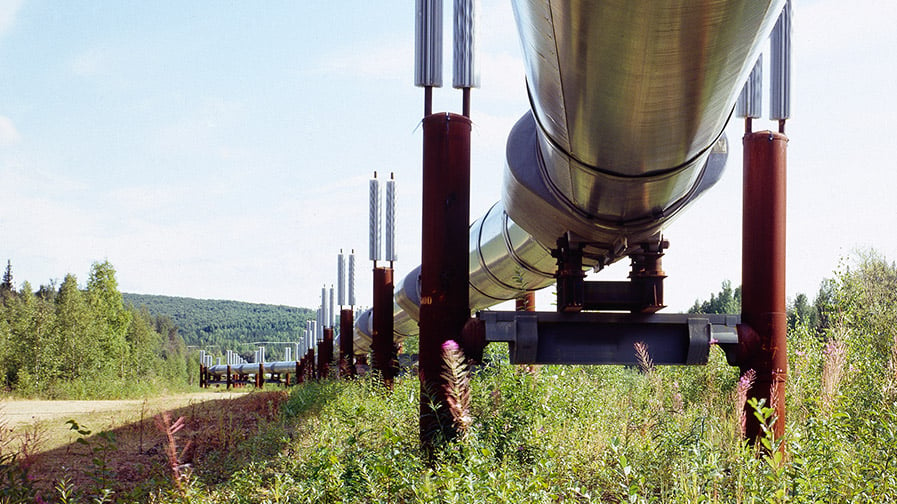
Gas pipelines are notoriously leaky pieces of fossil fuel infrastructure,105Gittelson (2022) at 355. and factory farm gas projects take as given the use or build-out of pipelines. Creating biogas pipeline grids among clusters of digesters is one of the best ways for these companies to save money along the way, but it poses even more risks than traditional natural gas pipelines. This is due to the potential for overpressure from changes in demand and the toxic and corrosive properties of factory farm gas, endangering people and workers unfamiliar with the gas.106Weiss, Alexander et al. “Let’s Talk About Biogas … Even if We Think it Stinks.” Yale Law School. CAFE Law & Policy Lab. Spring 2020 at 5; Hengeveld, E. J. et al. “Biogas infrastructures from farm to regional scale, prospects of biogas transport grids.” Biomass and Bioenergy. Vol. 86. January 18, 2016 at 47.
Big Ag and Big Oil cannot be trusted to protect communities from their own creations as they plot to expand existing fossil fuel infrastructure. One of Smithfield’s projects in North Carolina, for instance, is building out a 30-mile pipeline right through residents’ backyards, but the company was reluctant to release any information on what steps it would take to protect people when explosions or leaks occurred.107Johnson (2021). Residents are right to be fearful, as pipeline accidents resulting from human error, natural disasters, and material corrosion are all but inevitable.108Oldenburg, Curtis M. “Health, safety, and environmental risks from energy production: A year-long reality check.” Greenhouse Gases: Science and Technology. Vol. 1, No. 2. April 2011 at 4. Bioenergy Devco’s project in Delaware is tied to similar pipeline expansions, potentially located adjacent to an elementary school.109Layton, Greg. “Delaware is doubling down on factory farm biogas. It’s not a good thing.” FWW. March 8, 2022.
In their desperation to keep fossil fuel infrastructure relevant, these corporations once again dismiss people’s lives and communities.
If pipelines are not used for transport, companies may turn to heavy shipping trucks after fuel upgrading or to transport feedstocks. The use of trucks often depends on the type of feedstock, with poultry litter being one of the more long-distance options,110International Renewable Energy Agency (IRENA). “Biogas for Road Vehicles: Technology Brief.” Updated March 2018 at 6 and 15. and is just another example of the collusion between these two industries. Bioenergy Devco’s project could require an estimated 73,000 truck trips per year, many of which would not have occurred otherwise.111FWW et al. Letter to Secretary Shawn M. Garvin. Delaware Department of Natural Resources and Environmental Control. December 2, 2022 at 14. On file with FWW. The Shell-sponsored Nature Energy project boasts similar numbers, with a projected 90 to 100 trucks used daily to operate the facility 24/7.112Rogers, Chris. “Manure digester proposed in Wilson Township.” Winona Post. March 15, 2023.
Since pipelines, gas grids, or trucks are the only available methods of transport, these companies aim to necessitate fossil fuel infrastructure remaining in place as long as factory farm gas remains in use.113IRENA (2018) at 6 and 15. Interconnection into existing natural gas systems is key for many of these projects, ensuring that gas products continue to heat people’s homes or fuel their vehicles.114Rogers (2023); Carruth (2021); Chevron (September 2020); Adair (2021). The marriage of these two industries is just another tactic to avoid switching away from their profitable pollution and further entrench fossil fuels.
Factory farm gas will worsen local air and water quality
It is a well-documented fact that individuals living near factory farms face adverse health effects and higher mortality risks, not limited to kidney diseases, respiratory conditions, blood pressure elevation, and low birth weight.115Gittelson (2022) at 357; Wing, Steve and Jill Johnston. The University of North Carolina at Chapel Hill. Department of Epidemiology. “Industrial Hog Operations in North Carolina Disproportionately Impact African-Americans, Hispanics and American Indians.” August 29, 2014 at 1. The companies behind this proclaim that their biogas projects will protect local air and water quality.116Chevron (October 2022). This is flatly not true, since factory farm gas fails to address many non-methane consequences of industrial factory farming, including air and water pollutants, and creates its own set of risks.
Non-greenhouse gas air pollutants from factory farms include ammonia, hydrogen sulfide, volatile organic compounds (VOCs), and particulates, among others.117Gittelson (2022) at 353. While a good portion of emissions and pollutants are present before digestion takes place, factory farm gas construction and production will bring its own toxins — from the exhaust generated from the use of heavy equipment and vehicles to the potential odors that will come with the transport of manure and other material used for digestion.118CalEPA (2010) at 12 and 13.

Raw manure containing sulfur is converted to hydrogen sulfide in the digester, reaching over 4,000 parts per million in the gas. Usually, this is converted into sulfur dioxide and sulfuric acid air pollutants once burned, carrying their own risks.119Vermont DEC (2023); New Jersey Department of Health (NJDOH). [Fact sheet]. “Hazardous Substance Fact Sheet: Sulfur Dioxide.” Updated May 2010 at 1 to 2; NJDOH. [Fact sheet]. “Hazardous Substance Fact Sheet: Sulfuric Acid.” Updated March 2016 at 1 to 2. Sulfur dioxide is an irritant for the respiratory system, and repeated exposure can cause bronchitis or other health issues, including decreased fertility.120NJDOH (2010) at 1 to 2. This substance is highly poisonous, corrosive, and flammable, posing risks to those living nearby.121Arizona Department of Environmental Quality. “Class II Air Quality Permit.” Draft Permit No. 90062. 2021 at 24. Other trace pollutants, including lead, copper, and carcinogens like arsenic, are present in factory farm gas at higher levels than in fossil fuels.122Oglesby, Cameron. “’This plan is a lie.’ How biogas could do more harm than good for the hog industry.” Scalawag. March 24, 2022.
Water quality problems from factory farms are similarly well-documented, stemming from manure lagoon leakage and runoff from spray fields. Each of these contaminate surface or groundwater and remain in use with factory farm gas production.123Ibid. at 353; Johnson (2021). For instance, digesters do not solve nitrate contamination or phosphorus loading in soils or nearby waterways, since there is no monetary benefit to doing so. Liquid effluent, left over after production, is typically reapplied to land while still retaining nitrogen and phosphorus.124Vermont DEC (2023). In fact, factory farm gas may lead to more excess nutrients leaching into soil or water than a fossil fuel alternative.125Hijazi et al. (2016) at 1299.
Moreover, the systems are also known to leak or break. A farm in North Carolina that accepted waste from Smithfield and sold biogas to Duke Energy illegally discharged fecal matter, liquefied hogs, and old meat into surrounding wetlands and the Nahunta Swamp. The farm repeatedly accepted more than it was permitted to and overfilled the lagoons. Even after reporting the accident, it took months before it was resolved, leaving behind groundwater with over 17 times the legal limit of ammonia.126Sorg, Lisa. “Hog farm that used dead pigs, spoiled meat as fuel for biogas digester fined $34K.” Pulse. December 6, 2022.
Clearly, “green biogas” does not solve the problems with factory farms. Instead, by ensuring that factory farms are the primary source of this gas,127Weeks, Abigail. University of Colorado, Boulder. “Evaluating the social equity impacts of California’s carbon offset programs.” March 29, 2021 at 38. it will ensure that biogas’ growth is tied to that of factory farms and worsen pollution.
Factory farm gas threatens small producers and local economies
Over the past few decades, small and medium-sized farms have been decimated across the U.S. as agricultural giants dominate livestock production.128McGreal (2019). Now, Big Ag and Big Oil are arguing that biogas is the key to revitalizing local economies and family farms, as if the issue has merely been the lack of revenue from waste.129Johnson (2021); Chevron (October 2022). The reality is that factory farm gas creates few jobs, and those that do exist are dangerous and unregulated. There are also few viable routes for small-scale farms, incentivizing factory farm growth at the cost of local farms.
Factory farm gas will create a handful of jobs for projects springing up across the country, but the job of handling manure is dangerous. Many animal agriculture workers are unprotected by labor laws, leaving factory farm gas expansion a risk to their safety. Working with biogas killed a farmworker in Iowa in 2021, and no federal agency was required to investigate. Expansion of herd sizes increases risk levels for workers, as increased waste and corresponding decreased air quality raises dangers for long-term illnesses.130Lydersen (2022); Oglesby (2022).
This type of accident is no fluke. A study of factory farm gas accidents around Europe found that increased digester development has led to a higher number of operational accidents. The study examined more than 200 accidents and found that explosions and leaks resulted in a number of worker injuries on biogas plants. In more extreme instances, hazardous conditions at plants have led to worker deaths. Researchers concluded that the number of accidents likely exceeds what is recorded.131Travnicek, Petr et al. “Quantitative analyses of biogas plant accidents in Europe.” Renewable Energy. Vol. 122. 2018 at 89 and 92.
Factory farm gas also does not help small family farms — quite the opposite. It drives the expansion of factory farms by putting more pressure on small and mid-sized farmers. Digesters in the U.S. are located on the largest 10 percent of dairies.132Weeks (2021) at 38. This gas incentivizes these large factory farms to continue producing and even expand, by turning what was once waste into a new, more profitable revenue stream. Factory farm gas distorts agricultural markets, putting smaller and more sustainable farms at a disadvantage.133Kelloway (2022). This is because digesters are not cheap, costing up to $5 million each, and in the case of dairies, they require at least 3,000 cows to operate profitably.134Wozniacka, Gosia. “Are dairy digesters the renewable energy answer or a ‘false solution’ to climate change?” Civil Eats. April 24, 2020; Lauer, Markus et al. “Making money from waste: The economic viability of producing biogas and biomethane in the Idaho dairy industry.” Applied Energy. Vol. 222. April 8, 2018 at abstract.
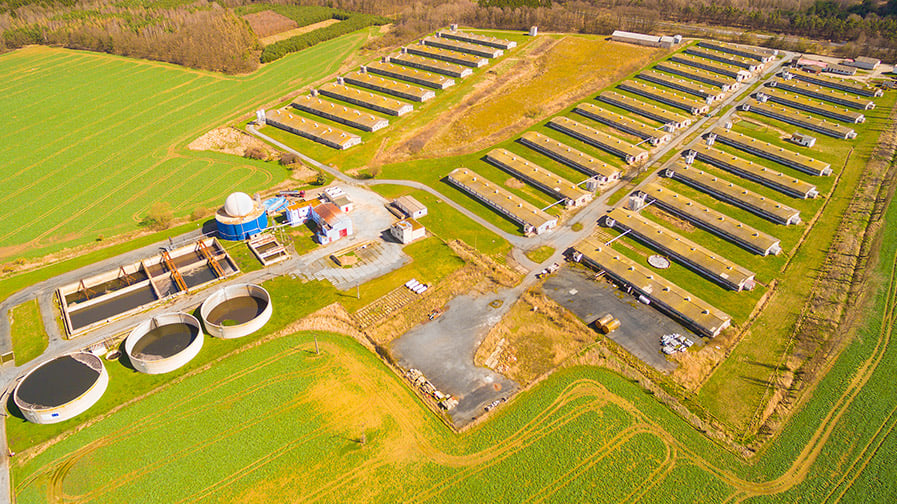
When Smithfield says that its projects benefit family farms,135Johnson (2021). it really means they benefit factory farms directly owned by or under contract with Smithfield. In the company’s Align RNG project, the 19 farms providing gas have a total of 250,000 hogs — an average of 13,000 each.136Saylor, Teri. “Cleaning the air.” Business North Carolina. February 2020. Shell’s projects trend the same way, with its new plants needing 15,000 cows within a 20- to 30-mile radius to run 24 hours a day.137Beach (2022). Chevron similarly admits that it partners with farms that have the “scale” to “enable a commercial project.”138Chevron (September 2021) at 18. These are not the small farms that biogas proponents would lead one to believe, and the money follows a similar trail.
The slew of public incentives dedicated to propping up factory farm gas has turned manure into a commodity half as valuable as cow’s milk.139Smith (2021). Funneled into greedy hands, these public incentives are only going to a few companies. For instance, all of California’s Digester Research and Development 2022 awards went to just two companies: Maas Energy Works and CalBio. CalBio is known for its tight collaborations with Chevron and the dairy giant Land O’ Lakes.140California Department of Food and Agriculture. “2022 Dairy Digester Research and Development Projects Selected for Award of Funds.” Updated September 2022. Available at https://www.cdfa.ca.gov/oefi/DDRDP/docs/2022_DDRDP_ProjectsAwarded.pdf and on file with FWW; van Deelen, Grace and Emma Foehringer Merchant. “Just two development companies drive one of California’s most controversial climate programs: Manure digesters.” Inside Climate News. September 20, 2022. The awards have trended like this for years, with CalBio receiving nearly $100 million from 2015 to 2019.141Wozniacka (2020).
Profits go straight to Big Ag and Big Oil, as they sell factory farm gas and collect as many low-carbon incentives as possible.142Gittelson (2022) at 359. The LCFS, for example, gives Shell credits worth tens of millions of dollars every year for the company’s factory farm gas.143Charles, Dan. “How dairy farmers are cashing in on California’s push for cleaner fuel.” NPR. February 10, 2022. Federal funding is also overwhelmingly directed to mega-dairies. According to the EPA’s AgSTAR database, which tracks livestock anaerobic digesters across the country, only 10 of the 108 listed digesters that receive USDA funding fall below thresholds144Note: Food & Water Watch defines factory farms as those confining 500 dairy or beef cows or 1,000 hogs. for factory farms.145EPA. AgSTAR. “Livestock Anaerobic Digester Database.” Available at https://www.epa.gov/agstar/livestock-anaerobic-digester-database and on file with FWW. Accessed February 2023.
The truth is that these incentives are not designed for or accessible to small dairies. California’s offset programs are simply one example of this, with the program used primarily by dairy farms of more than 1,000 cows.146Weeks (2021) at 42. Small hog farms would need government subsidies to cover over half of capital costs simply to break even.147Cowley, Courtney and B. Wade Brorsen. Oklahoma State University. “Anaerobic digester production and cost function.” 2018 at 19 to 20. But even then, the economies of scale work so that as methane (and therefore herd size) increases, costs decrease, further advantaging factory farms.148Ibid. Should other states or regions take this incentive route, the factory farm gas industry will grow at the continued expense of America’s small farmers.
Factory Farm Gas Perpetuates Environmental Injustices
Despite all the above, the most egregious effects of factory farm gas are those it has on low-income communities and communities of color across the country. Factory farms have long been disproportionately located in low-income and non-white areas, and those communities have borne the bulk of the harms associated with them.149Gittelson (2022) at 356. In particular, hog projects are concentrated in areas with higher Black, Latinx, and American Indian populations, meaning that digesters like Smithfield’s will often be as well.150Johnson (2021).
Align RNG has already announced projects in Sampson and Duplin counties in North Carolina, where half of the residents are Black or Latinx.151Oglesby (2022). Nearly all residents live within three miles of hog operations.152Kaplan, Sarah. “Air pollution from farms leads to 17,900 U.S. deaths per year, study finds.” Washington Post. May 10, 2021. Locals worry about their families’ health and safety, particularly in these rural areas where infrastructure is weaker. They worry that emergency response teams would be unable to reach victims in the event of an explosion.153Johnson (2021).
These concerns are valid — in Duplin County, researchers found that 89 premature deaths annually are directly caused by hog farm emissions.154Kaplan (2021). Ammonia, in particular, is highly reactive and released by manure and fertilizer on farms. It is also notoriously difficult to detect and monitor.155Ibid. Pathogens and other toxins contained in hog feces are sprayed onto fields, contributing to weakened immune systems and diseases like tuberculosis.156Oglesby (2022).
Similarly, Bioenergy Devco’s project is located near communities of color. In Seaford, Delaware, people of color make up around 32 percent of the population within the three-mile radius of the proposed anaerobic digester. While this is a similar racial composition to the rest of the state, it is starkly different from the rest of Sussex County, which is 17 percent people of color. Likewise, more than a third of the population within the three-mile radius lives below the poverty line, compared to 12 percent of Sussex County. And over half of the households within the three-mile radius of the facility have incomes below the state and county median household income, with nearly 30 percent of those households earning $25,000 or less a year and 15 percent bringing home under $15,000.157U.S. EPA. Enforcement and Compliance History Online (ECHO). Detailed facility report for 28338 Enviro Way, Seaford, Delaware. Available at https://echo.epa.gov/detailed-facility-report?fid=110016705252#demographics110016705252. Accessed June 2020; U.S. Census Bureau. QuickFacts. Accessed March 2021.
Communities that experience these environmental injustices experience underdevelopment and destabilization, adversely impacting the overall quality of life.158Gittelson (2022) at 353. Since digesters fail to address the negative externalities associated with factory farms and even exacerbate them by incentivizing expanded herd sizes, these localities will only continue to face harms at the hands of Big Ag and Big Oil.
Conclusion
For all the industry’s talk about how much research must be done on solutions, we already know how to address these crises — by moving away from the factory farm model toward a more sustainable food system and halting all fossil fuel energy and infrastructure in favor of renewables. All the funding, federal and private, being funneled into digesters both props up Big Agribusiness and diverts resources and attention from forward-looking solutions. Small-scale farms are much better off using alternative manure management practices, like composting, dry scraping, or pasture-based systems, which are cost-effective, faster to implement, and lower-emission.159Wozniacka (2020).
None of these solutions require the collusion of Big Oil, which is why the industry would prefer to rely on dirty factory farm gas and fossil fuel infrastructure. Investing in more fossil fuel infrastructure and building out pipelines to greenwash reputations intentionally prolongs gas dependence, delaying the shift to truly clean energy and emission reductions. These projects are cropping up fast, like Shell’s project in Minnesota, which proposes to construct a massive industrial facility outfitted with 197-foot-tall exhaust stacks and 46-foot-tall gas tanks.160Rogers (2023). Such a project is a crisis for local communities, and rather than continuing to prop up fossil fuel companies with incentives to produce more dirty energy, we must be quickly transitioning to a 100 percent renewable energy future.
Food & Water Watch recommends:
- Congress must pass the Farm System Reform Act.
- Congress must stop subsidies for digesters.
- Congress must ban fracking.
- All levels of government must stop approving new gas infrastructure.
Show Congress your support for the Farm System Reform Act!

Time to face it —~it’s people or plastics.~We can’t have both.
Become a plastic pollution fighter this Earth~ Day and have your gift MATCHED $3-to-$1!
Endnotes



